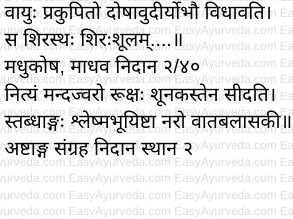Vatabalasaka Jwara Causes, Symptoms, Treatment
By Dr Raghuram Y.S. MD (Ay) & Dr Manasa, B.A.M.S
The fever which is caused by combined vitiation of vata and kapha is called vatabalasaka jwara. Kapha is the predominant dosha in this fever. Some consider this fever to be caused predominantly by vata. But it is wise to consider that vitiated vata is the provoking factor here. Vitiated kapha provoked by vitiated vata and later both having a vicious association produce vatabalasaka fever. Therefore the authors have specified the predominance of kapha in the pathogenesis of vatabalasaka fever. Balasa is a synonym of kapha.
Master Gananath Sen ji and other contemporary authors have considered vatabalasaka fever as a variant of vishama jwara i.e. irregular fever.
Vatabalasaka fever is caused by all three doshas with predominance of vata and kapha. It is said that in spite of vata and kapha being predominant, vatabalasaka fever is caused by simultaneous vitiation of all three doshas. This means to say that pitta is also involved to a certain extent but its symptoms are not predominantly evident in this fever. This is made clear by a reference from another treatise mentioned in the Madhukosha commentary of Madhava Nidana 2/40.
According to this reference – ‘The aggravated vata vitiates and provokes both kapha and pitta and causes vatabalasaka fever’.
Read – Jwara Pravritti – The Initial Manifestation

Table of Contents
Symptoms
Nityam mandajwaram – presence of mild fever every day
Ruksha – dryness in the skin brought about deterioration of unctuousness of pitta afflicted by vitiated kapha and vata
Shuna – swelling in a part of the body or the entire body
Sidati – the person is distressed or unhappy / swelling subsides with difficulty
Stabdhanga – stiffness / rigidity of the body parts, unable to move easily
Causes
Causative factors of vatabalasaka fever have not been mentioned. By inference vata and kapha aggravating etiological factors need to be considered as causal.
Read – Charaka Jwara Nidana: 1st Chapter
Treatment
Vatabalasaka fever shall be treated on the lines of –
– General line of treatment of fever
– Treatment of fevers of vata, kapha and vata-kapha origin in accordance to the predominant symptoms at the time of diagnosis
– Line of treatment of swelling / shotha
Read – Charaka – Jwara Chikitsa 3rd Chapter
Sanskrit Verses

Probable Modern Correlation
Vatabalasaka Jwara is compared to epidemic dropsy due to closeness of clinical picture between both conditions. Some experts have correlated it with Beri Beri which seems to be an incorrect correlation.
Epidemic dropsy
It is a form of edema of extremities. It is caused due to poisoning by Argemone Mexicana, consumption of oils adulterated with the seed oil of the mentioned herb to be precise. This occurs as an epidemic in places where mustard oil (oil extracted from Indian mustard – Brassica juncea) is used in excess for cooking purposes.
Argemone oil has two main toxic alkaloids by name Sanguinarine and dihydrosanguinarine. When this oil is used to adulterate mustard oil or is accidentally added it causes proteinuria. This leads to edema as would occur in nephritic edema.
Symptoms of epidemic dropsy
Bilateral pitting edema of extremities
Headache
Nausea
Loose stools
Breathlessness
Glaucoma
Erythema
As the disease advances cough, shortness of breath and orthopnea progresses to right sided congestive cardiac failure. Though there is no mention of fever among the symptoms of epidemic dropsy we may assume that the fever might be mild, as mentioned in vatabalasaka fever, and hence not specifically mentioned among the list of medicines in modern medicine. Most of the symptoms of epidemic dropsy seem to be similar to those of high kapha in the system. Some symptoms point towards involvement of vata – like headache, and pitta – like erythema.
Treatment
There is no specific treatment of this condition. The main strategies of treatment include –
Removal of disease causing adulterated oil and keeping away from it
Symptomatic treatment, especially those of cardiac and respiratory symptoms
Usage of antioxidants and multivitamins
Formulations From Sahasra Yoga Text Book for Vata Jwara
Vata Jwarahara Kashaya
Vata pitta kapha jwarahara Kashaya
Dasomoola Vrishadi Kashaya
Kiratadi Kashaya
Formulations From Sahasra Yoga Text Book for kapha Jwara
Vata pitta kapha jwarahara Kashaya
Dasomoola Vrishadi Kashaya
Bhunimbadi Kashaya
Click to Consult Dr Raghuram Y.S. MD (Ayu)








